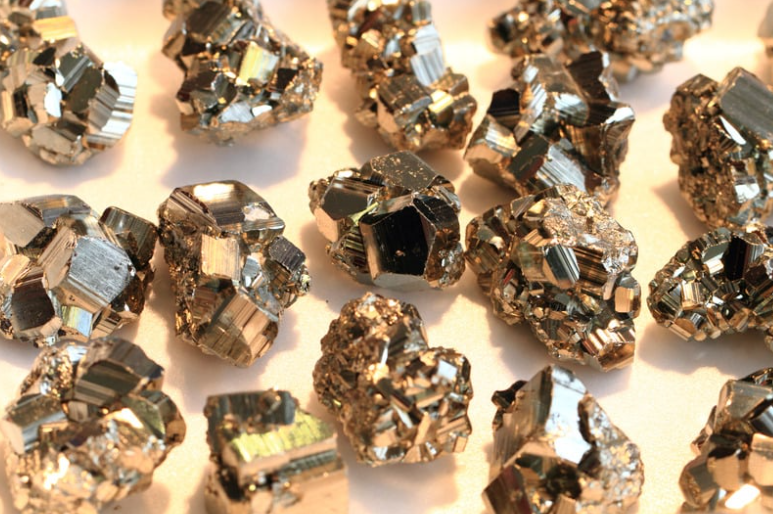
Fool's Gold (Pyrite)
Share
I must be either a fool or a magpie, because I love pyrite—its glitter, its sharp cubes and octahedrons, its heaviness in the hand. This stone evokes the dragon’s hoard. It sparkles in darkness like the glint of an eye. It reminds us of gold, but it’s harder and much more abundant. Pyrite can help create fire; its name comes from the Greek pyr meaning “fire,” alluding to the sparks that fly when it is struck with another rock.
Deep underground where the oxygen is low, iron and sulfur talk to each other. They commingle in hydrothermal veins when hot, mineral-rich water flows through fractures in the rock. Or in ancient seabeds and coal deposits, organic matter releases sulfur as it decays, then reacts with existing iron. Or during metamorphism, iron-rich minerals are subjected to immense heat and pressure. All these different processes lead to the formation of pyrite.

Pyrite is abundant. It occurs in all types of rock (igneous, sedimentary, and metamorphic). It forms all over the world. It is the most common sulfide mineral on the planet, with a brassy, yellowish sparkle that makes it easily confused with gold. And while pyrite may contain trace amounts of gold in its structure, the amount is so small as to be rather insignificant. Pyrite itself is far more plentiful.
Pyrite is so plentiful, in fact, that it has been mistaken for gold over and over throughout history. For example, English explorer Sir Martin Frosbisher discovered what he believed to be gold on Kodlunarn Island in Canada. He subsequently shipped 1,400 tons of it back to Europe. But when the “gold” arrived in Dartford to be smelted, it was found to be pyrite. Another instance involved the colonists at Jamestown, who made the same mistake when they rowed up the Potomac River. The river’s sands glittered with golden fragments, which caused quite a bit of excitement amongst the crew. Captain Newport promptly shipped 1,100 tons of the substance back to England… where, again, it was discovered to be pyrite.

How, then, does one tell the difference between pyrite and gold?
The two substances may look alike, but they couldn’t be more different. Where pyrite is a mineral that forms in the Earth’s crust, gold is an element. Gold cannot be formed like pyrite; it is forged in the volatile processes of stars. Some research posits that most of the Earth’s gold comes from the debris of distant supernovae. As such, gold is incredibly rare on Earth, while pyrite is magnificently bountiful.
The easiest way to tell the difference between pyrite and gold is by assessing color and luster. While both substances shimmer in sunlight, pyrite’s shine is brighter and reflects more light, like polished brass. Gold, on the other hand, retains more of its solid color in direct sunlight. Gold also normally bears a well-saturated yellow color, whereas pyrite is brassier and its yellow tones are usually more pale or even silvery.
(Above: gold)

(Above: pyrite)
Another way to distinguish between pyrite and gold is by evaluating hardness. At a rating of 6 - 6.5, pyrite is much higher on the Mohs scale than gold, which ranks at 2.5. Gold is malleable; it will bend easily in your hands. Pyrite has almost the same hardness as quartz, so it would take significantly more effort to break or scratch it.
There are still more differences between pyrite and gold. Pyrite’s density is 4.8 grams per cubic centimeter, whereas gold in its purest form has a density of 19.3 grams per cubic centimeter. Pyrite’s streak is greenish black; gold’s is yellow. Pyrite tarnishes, but pure gold cannot tarnish. Pyrite’s crystals bear striations (little lines and patterns on the faces), but there are no striations in gold.

Sure, gold is more rare and economically valuable than pyrite. And it’s true that in the metaphysical community, both are famous for their properties of abundance and prosperity. But I might argue that in some ways, pyrite promotes abundance even more so than gold does: it is, after all, much more generously distributed in the Earth’s crust. Whether or not you work with it metaphysically, pyrite shows us the richness of the planet and invites us to participate in this wealth. It can even help us reassess what wealth and value truly mean. Is wealth the arbitrary number by which a person is measured? Or is it the abundant mindset and generosity by which that person lives?
Perhaps pyrite isn’t a gold for fools, after all.
~~~
by Amber N. 2025

